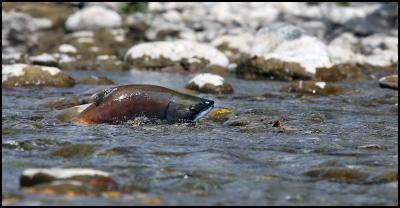Sockeye Salmon Are Spawning in the Mackenzie Country
Back From the Verge of Extinction – Sockeye Salmon Are
Spawning in the Mackenzie Country
27 March 2017
FOR IMMEDIATE RELEASE

Sockeye salmon with their red bodies and green heads burst out of the water as they make their way upstream to spawn in the Twizel River.
The Southern Hemisphere’s only population of the mysterious sockeye salmon has started its spawning run in the MacKenzie Country’s alpine rivers, providing the region with a new tourist attraction.
In the Twizel River,
the sockeye are passing under the State Highway 8 Bridge
near Twizel township, and the sight of hundreds of fish
moving up the river, and spawning right below the bridge,
has become popular with tourists and locals.
For many,
the chance to see these fish migrate is a once in a lifetime
event with dozens of people crowding the bridge to look at
them.
The sockeye are highly visible, often bursting out of the water in a shower of spray as they scramble across the riffles in their search for the ideal spot in the riverbed to lay their eggs.
The MacKenzie Country sockeye is the only population of the species in the southern hemisphere.
Released in 1901 as an attempt to create a sea-run salmon canning industry, the attempt failed when the sockeye never ran to the sea, leaving the Chinook salmon to become the basis for the South Island’s successful salmon fishery.
Sockeye were thought to have died out in the late 1980’s, however around 2005, Central South Island Fish & Game started receiving reports of them spawning once again. Now the sockeye can be found in their thousands heading upstream at this time of year to breed.
Central South Island Fish & Game Officer Jayde Couper says the sockeye’s comeback from the verge of extinction continues.
“This year the spawning effort appears to be wide spread and the numbers are reasonably high”.
“Sockeye have been observed in almost all of the Lake Benmore tributary rivers and streams, most notably the upper Ahuriri River and its tributaries, Lower Ohau River and its tributaries like the Twizel and Fraser Rivers, the Tekapo River and its tributaries like the Mary Burn and Forks River”.
Mr Couper says sockeye are also turning up in areas where they were not thought to exist.
“The other interesting observation this year is the Lake Pukaki population is flourishing, yet Fish & Game staff only heard about them existing there last year.
“There had not been any confirmed reports of sockeye in Lake Pukaki for decades, now this year there are around a thousand spawning fish in just one of the lake’s tributary streams.”
Jayde Couper warns people against disturbing the fish.
“It is worth noting that it is an offence under the Conservation Act to disturb spawning salmon – you can’t catch, net or spear the fish, or even walk in the river bed and trample their redds, or nests.
Jayde Couper says this is why the Twizel bridge site is so popular, as people can watch the fish from above without disturbing them.
Despite their
numbers, sockeye are rarely caught by anglers as they filter
feed on plankton and are not normally attracted to an
angler’s lure,
They live in the lakes and are only seen
when they run the rivers and streams to spawn.
Sockeye’s main value is as a food source for native fish, trout and Chinook salmon and this helps to maintain the productive and popular lake fisheries at Ohau, Benmore, and Aviemore.
Because they were thought to be extinct, Fish & Game didn’t count the sockeye for a number of years. The re-emergence of the species means the organisation is now developing a field method capable of estimating the total Upper Waitaki catchment spawning run.
“There are too many salmon and not enough time and resources to count them all,” Mr Couper says.
“However, the fact sockeye appear to have come back from the dead is heartening and a positive sign of the health of the fishery in the Waitaki Lakes”.
Video: https://www.youtube.com/watch?v=hakIHWMKXbQ&t=108s
ENDS


 Gordon Campbell: On The Hikoi Arrival, And Taylor Childers
Gordon Campbell: On The Hikoi Arrival, And Taylor Childers Palestinians for Hīkoi mō te Tiriti: Statement From Palestinian Leaders - Hīkoi Mō Te Tiriti Is A Historic Moment For All In Aotearoa
Palestinians for Hīkoi mō te Tiriti: Statement From Palestinian Leaders - Hīkoi Mō Te Tiriti Is A Historic Moment For All In Aotearoa Anglican Church in Aotearoa: Anglican Archbishops To Join Hīkoi Mō Te Tiriti In Wellington
Anglican Church in Aotearoa: Anglican Archbishops To Join Hīkoi Mō Te Tiriti In Wellington Wai Ako Books: Best-Selling Author & Lawyer Creates Free Easy Tool To Help Kiwis Oppose Controversial Treaty Bill
Wai Ako Books: Best-Selling Author & Lawyer Creates Free Easy Tool To Help Kiwis Oppose Controversial Treaty Bill Asians Supporting Tino Rangatiratanga: Asian Communities From Across Aotearoa Join Hīkoi Mō Te Tiriti
Asians Supporting Tino Rangatiratanga: Asian Communities From Across Aotearoa Join Hīkoi Mō Te Tiriti Cooper Legal: Censorship Is Alive And Well In New Zealand
Cooper Legal: Censorship Is Alive And Well In New Zealand NZ Government: NZ Signs Trade Deal With Costa Rica, Iceland And Switzerland
NZ Government: NZ Signs Trade Deal With Costa Rica, Iceland And Switzerland


